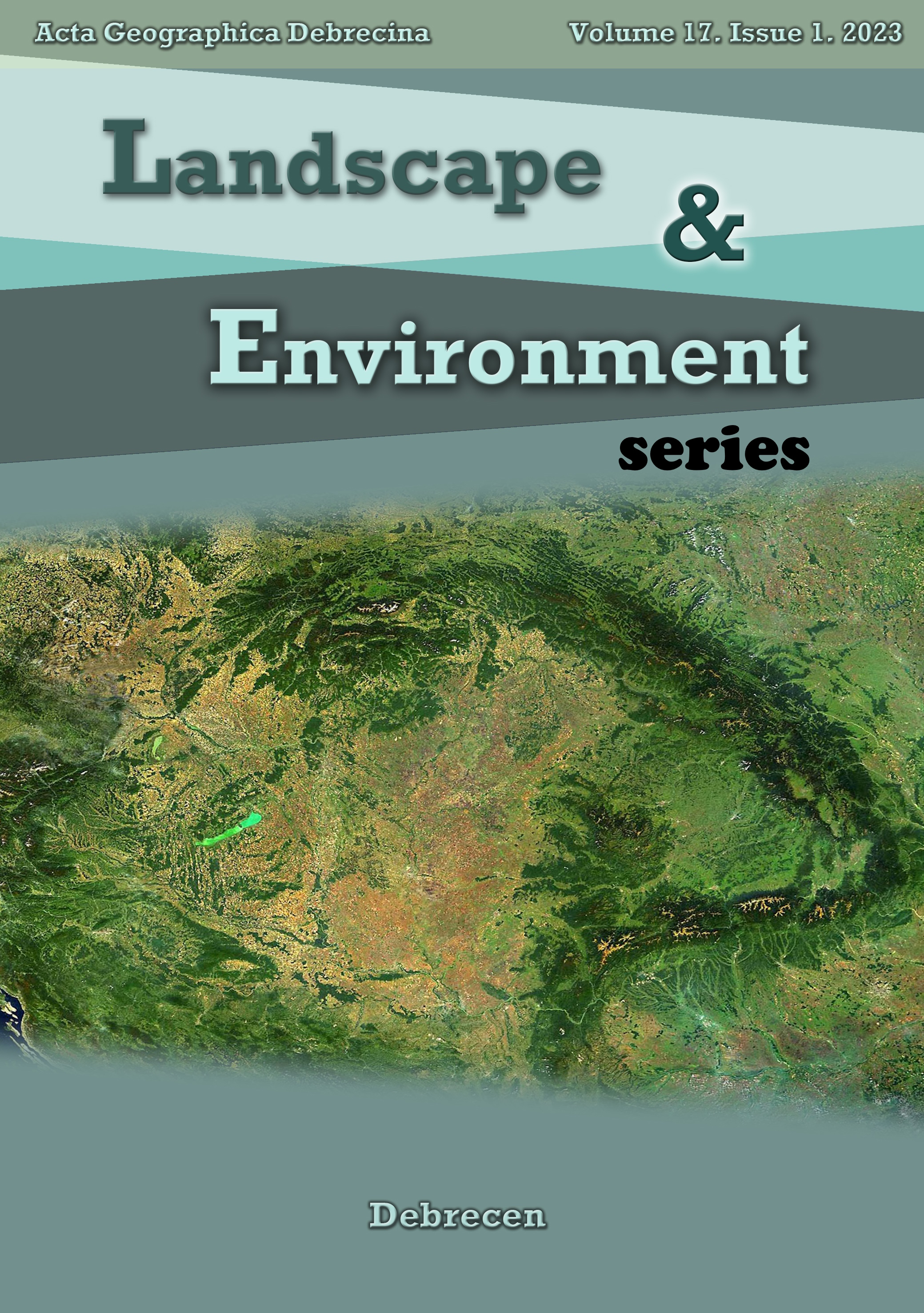Vol. 17 No. 1 (2023)
Ayoub Barkat – Foued Bouaicha – Zakaria Rahal – Tamás Mester – György Szabó. Evaluation of climatic conditions from 1978 to 2020 of Oued Souf Valley (Southern East of Algeria)
Arunkumar K.S – Anoop K.G. – Jobin Thomas. Landslide susceptibility mapping using the analytical hierarchy process and GIS for Idukki district, Kerala, India
Tamás Molnár – Géza Király. Sentinel-2 satellite-based analysis of bark beetle damage in Sopron Mountains, Hungary
S. Chaurasia – S. N. Mohapatra. Time series analysis of major land resources Using landsat images in a part of district Jhansi, Uttar Pradesh, India
Viktor Márk Lénárt. Climate change: Hungary’s perception and how we adopt renewables against it
##issue.tableOfContents##
Articles
-
Evaluation of climatic conditions from 1978 to 2020 of Oued Souf valley (Southern East of Algeria)
1-10Views:168In this research, a climatic synthesis was built to assess the climatic parameters of the Oued Souf Valley through the meteorological data obtained from Guemar station (airport). It was revealed that the hydrological year of Oued Souf Valley is branded by the presence of a dry period and the total absence of a wet period over the year, even during January, when it was observed to have the lowest temperature and highest precipitation, which classified it as a Saharan climate (Hyper arid). The irregularity and the scarcity of precipitation, high temperatures and extremely high evapotranspiration had significant repercussions on surface runoff and infiltration which implies a high pressure on the water resources of Oued Souf valley and may disrupt the future socioeconomic project and increase the damage of natural drought and desertification.
pdf120 -
Landslide Susceptibility mapping using the Analytical Hierarchy Process and GIS for Idukki District, Kerala, India
11-32Views:357This study demonstrates the application of the analytical hierarchy process (AHP) technique for landslide susceptibility mapping of Udumbanchola and Devikulam taluk of Idukki district (Kerala, India). The landslide conditioning factors, such as lithology, geomorphology, slope angle, slope aspect, relative relief, drainage properties, land use/ land cover, and lineament characteristics,are derived using remote sensing data and GIS. The landslide susceptibility of the region is estimated using the weights derived by the AHP method. The analysis indicates the controls exerted by the structural and fluvial process and relief characteristics on the landslide activity of the region. The landslide susceptibility map of the region suggests that the high and severe susceptible zones cover about 10.68% of the area, and another 9.40% falls under the moderate susceptibility zone. The results highlight the significance of implementing various structural and non-structural measures in the moderate to severe susceptibility zones to mitigate the impacts of landslides.
pdf204 -
Sentinel-2 satellite-based analysis of bark beetle damage in Sopron Mountains, Hungary
33-40Views:143Sopron mountains were affected by bark beetle (Ips typographus) damage between 2017 and 2020, which was surveyed on high-resolution ESA Sentinel-2 satellite images for the period 2017 and 2020 using Mosaic Hub, Anaconda, and Jupyter Notebook web-based computing environments. Biotic forest damage was detected based on vegetation (NDVI) and moisture (MSI, NDWI) indices derived from satellite images. The spatial and temporal change of damage was observed in the image series, resulting in information about the level of degradation and regeneration. In pursuance of GIS processing, 84 forest compartments were compared, which showed in most of the cases (97%) negative interannual change in the index mean values (MSI = - 0.14, NDWI = - 0.2, NDVI= - 0.19) when years compared to each other. The remote sensing-based survey was marked out and validated based on the forest database of the Hungarian Division of Forest of National Land Centre and forest protection damage reports of the Hungarian National Forest Damage Registration System.
pdf104 -
Time series analysis of major land resources using Landsat images in a part of district Jhansi, Uttar Pradesh, India
41-57Views:137Space born technology, with its repetitive nature, uses electromagnetic energy to capture digital data from the Earth's surface by remote sensing systems. The purpose of this research is to track changes in land resources with six time series (2003-09, 2003-15, 2003-21, 2009-15, 2009-21 and 2015-21) over a period of 18 years. Multi-date Landsat images of 2003, 2009, 2015 and 2021 have been used to monitor the changing pattern. Level – I classification scheme composed by NRSC/ ISRO and supervised Maximum Likelihood Classification (MLC) techniques were used to identify and classify land use/ land cover features located in Jhansi Tehsil. The findings show that there have been significant changes in land resources over the years. The area under agriculture land, built-up and waterbodies were increased by 48.83%, 53.53% and 106.73% while forest/ tree outside forest and wastelands were reduced by 59.74% and 38.68% respectively It is concluded that, the expansion of key land resources indicates the growth in population and socio-economic activities whereas the loss in some land resources might be due to human induced progressive activities.
pdf130 -
Climate change: Hungary’s perception and how we adopt renewables against it
58-65Views:85The aim of the research is to present the effects of climate change in Hungary, the public opinion on climate change and the related social acceptance of renewable energy sources and the reasons for their adaptation. Previous surveys have shown that the Hungarian population is aware of the dangers of climate change, yet they are less willing to act against either climate change or pollution. Global climate change threatens peripheral regions more than central regions, as several studies have shown. Hungary has so far successfully met its climate targets but is still far from reaching the 2050 climate neutrality target. The financial and economic situation of the Hungarian population does not currently allow them to widely adopt the opportunities offered by renewable energy sources, but those who can afford to invest in the technologies do so primarily for the financial savings, not to fight climate change.
pdf100
